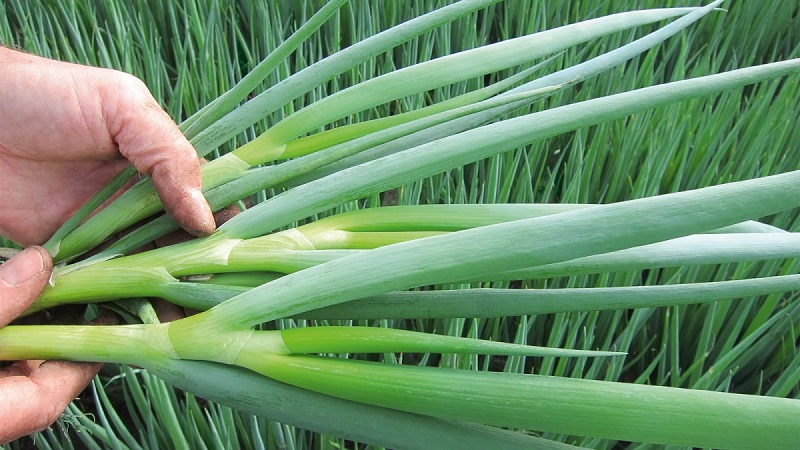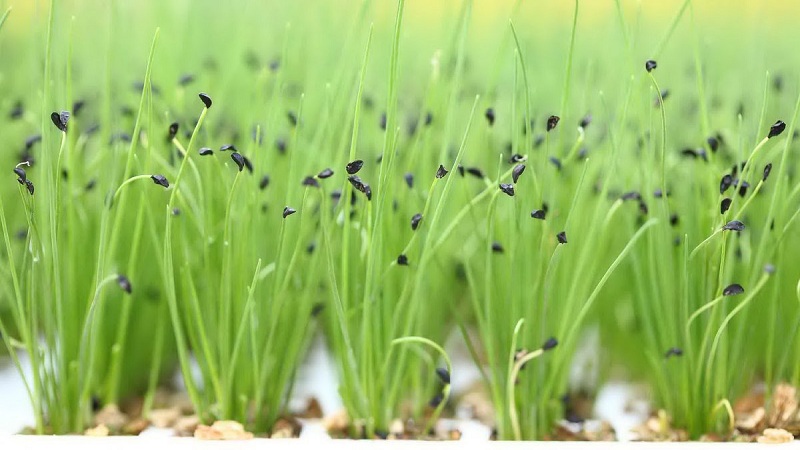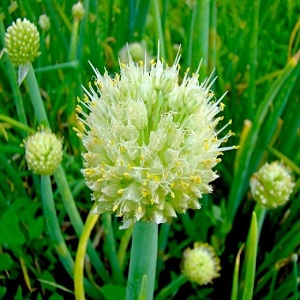How to properly grow batun onions: planting and care in the open field
Tatarka, fluffy onion, winter, Welsh, April - all these are the folk names of one plant - the batuna onion. The peculiarity of this species is the high and dense green mass and the absence of a rounded turnip. The culture is grown precisely for obtaining juicy greens with a delicate, sweetish, slightly pungent taste and a pleasant onion aroma. From the article, you will learn how to properly plant and take care of the onion in the open field.
The content of the article
Description of the crop and selection of varieties for open ground
Onion - a perennial plant from the Onion family. The homeland of culture is the territory of Asia. Grows wild in Mongolia and China. In Russia, the batun is cultivated almost everywhere, with the exception of the Far North. Caring for him does not cause any particular difficulties.
The ground part resembles onions - the stems are long, tubular, but located denser. The underground part is represented by a false, short, bleached stem and is devoid of a rounded turnip.
Batun onions are grown for the sake of greenery. The plant spends all its strength on the formation of tubular leaves. If they are not cut off in time, they can reach 60-70 cm in height and 20-25 mm in diameter. The maximum wall thickness is 1.5 mm. This feather is considered overgrown and unfit for human consumption due to its excessive hardness and lack of taste.
The false bulb, or stem, is also eaten. The bulk of the roots is located at a depth of 30 cm.
On the territory of Russia, due to climatic features, early or medium-early varieties of onion-batuna are grown:
- April - early ripening variety. Harvested in April. Differs in resistance to most onion diseases. The taste is pleasant, sweet-spicy.
- Russian winter - mid-early variety, frost-resistant. Leaves are bright green in color, up to 35 cm high. The taste is delicate, sweet.
- Baia Verde - mid-early variety. Green leaves, up to 40 cm high. The taste is sharp. The aroma is pronounced onion.
- Giant - medium early variety with high frost resistance. The leaves are thick, fleshy, up to 50 cm high. The taste is spicy-sweet.
- Seryozha - an early variety with high frost resistance. Leaves of a bluish-green hue, up to 55 cm high, with a pleasant, sweet taste without pungency.
- Guilder - mid-early variety. Leaves are juicy, tender, undersized, up to 40 cm in length. Medium-sharp taste.
- Damask - an early ripe variety. Feathers are green, erect, covered with a waxy coating. Stem height - 30 cm, diameter - 11 mm. The taste is pleasant, sweet.
- Zelenets - ultra-early variety. Feathers up to 80 cm long, bright green. The taste is sweetish, semi-sharp.
- Kaigaro - mid-season variety. Leaves are erect, bluish-green, up to 50 cm in height. The taste is delicate, sweetish, semi-sharp.
- Red - an ultra-early variety with the possibility of harvesting one month after planting. Feathers are tall, up to 70 cm long, green. The taste is pleasant, medium-sharp, sweetish.
- Emerald - early grade. Feathers are dark green in color, with a waxy coating, 70-85 cm long. The taste is delicate and sweet.
- Tenderness - ultra-early variety, ripens 30 days after sowing. Feathers are green, with a slight waxy coating, up to 35 cm high. The taste is sweet, semi-sharp.
The photo shows the onion.

Basic rules for growing onions in the open field
The culture is not particularly demanding for cultivation and care, however, a number of rules are followed to obtain a harvest:
- planting after legumes (undesirable after tomatoes due to the risk of infection with fungal diseases);
- soil pH rate - 6.5-7.5 units;
- the density of sowing seeds in the open field - 2 g per 1 m²;
- sowing width - 18-20 cm, depth - 1-2 cm;
- mulching the soil with humus after sowing, followed by compaction of the upper layer;
- soil moisture control;
- removal of weeds;
- double thinning of plantings when sowing a trampoline as a perennial;
- introduction of complex fertilizers.
Landing dates
Experienced gardeners are advised to focus on the climatic features of the growing region. The optimal sowing time is the beginning of March (harvest in June) or the first days of July (collection of greens in October).
During the winter When sowing, seed is embedded in cold, but not frozen ground. In the central regions this happens at the end of October. With early sowing, the seeds will begin to germinate before winter and die from severe frosts.
Preparation for growing
Planting onions begins with preparatory work: seed treatment, plowing and fertilization of the site.

Planting material
It is not recommended to pour the seeds into the furrows directly from the bag. This decreases the germination rate and increases the germination time.
To make the seeds of the batun germinate faster, they are soaked in a weak solution of potassium permanganate for 20 minutes, then put in clean water for 24 hours. The water is changed 2-3 times. To stimulate germination material process succinic acid, "Epin" or "Zircon". After soaking, the seeds are not washed and dried to flow.
For sowing, they take seeds collected on their site or purchased in stores for gardeners.
Priming
A plot for sowing onion-batuna is prepared in advance - in autumn or spring. The land is plowed to a depth of ½ with a bayonet. Deep digging does not make sense because of the compact root system.
In the process of digging, the soil is carefully examined and weeds are selected along with the roots. This is important, since the shoots of the trampoline are tender, like strings, and when pulling the weed out of the ground, it is easy to pull the onion along with it.
For productive cultivation, crops increase the nutritional value of the soil by applying fertilizers. Clay soil is loosened with the addition of sand (10 liters per 3 m²) or wood ash (200 g per 1 m²). Sour soil is deoxidized with dolomite flour - 400 g per 1 m².
When preparing the site in the fall, rotted manure is scattered over the dug up bed. 15 days before planting, 25-30 g of nitroammofoska are applied per 1 m².
Landing rules
The seeds are sown in rows. Furrows up to 2 cm are formed in the soil with an interval of 25-35 cm. The material is sealed at a distance of 15 cm. Gutted sowing with an interval of 5 cm with annual cultivation of a trampoline allows you to get aligned shoots and increase productivity. However, weeding and loosening of such plantings is difficult.
Dry grains without preliminary treatment are sown in dry soil, pickled and soaked in growth stimulants are embedded in moist soil. The furrows are watered abundantly with clean water and sowed when the water is completely absorbed.
A layer of soil is poured on top and re-watered. Then mulch with hay, straw or peat or cover with agrofibre.
Council. To facilitate the process of thinning plantings, mix black onion with radish seeds, which sprout much earlier. As the radishes are harvested, you will automatically thin the onions.
Features of growing by seedling method
Cultivation of trampoline through seedlings allows you to avoid troublesome weeding and get a harvest in 2-2.5 months from the moment of the first shoots.
To obtain seedlings, the seeds are pre-disinfected in potassium permanganate and soaked in water for 24 hours. Then they are sown in individual cups filled with a moist substrate from equal parts of turf and humus to a depth of 2 cm with an interval of 5 cm.Sprinkle with soil on top, cover with foil and wait for shoots.
Then the seedlings are taken out on a sunny windowsill, the film covering is removed. The optimum air temperature is + 16 ° C during the day and + 10 ... + 12 ° C at night.
Seedling care includes timely watering and fertilization (1 time in 14 days). To do this, use superphosphate or nitrophosphate (2 g per 10 l of water).
When the weather is warm outside, the threat of night frosts will disappear and the soil warms up to + 12 ° C, the seedlings are transferred to open ground. On the site, beds are formed with a depth of 1.5 cm. The seedlings are planted together with an earthen clod with an interval of 3 cm and covered with agrofibre for 3-4 days.
Further care
Rules for caring for planting onion-batuna:
- The frequency of watering directly depends on the amount of rainfall in the growing region. In a drought, the plant is watered 2-3 times a week. To obtain a large amount of greenery, watering is increased up to 4-5 times every 7 days. It is important not to allow the soil to dry out.

- Loosening of the beds is performed after each watering in order to prevent the formation of an earth crust and improve aeration of the underground part.
- Weeds are removed as they grow, without waiting for rooting. This is especially important at the very beginning of onion growth when the feathers are thin and weak.
- Thinning of seedlings is performed twice: the first time after the emergence of shoots, leaving a gap of 2-3 cm, and the procedure is repeated after the plant gets stronger, achieving a gap of 5-7 cm.
- When planted early at the end of June, the lower green feathers are pruned, leaving the young top to form lush greenery.
- Onions are fed twice a season: when planting - a solution of chicken manure diluted in a ratio of 1:15, after emergence - 10 kg of compost, 150 g of ammophoska per 1 m². It is enough to add 200 g of wood ash per 1 m² to fertile soil.
In autumn, the onion does not need care - the plant enters the sleep phase and firmly tolerates the cold until spring.
Diseases and pests
Subject to the rules of agricultural technology, the batun rarely gets sick, is not attacked insects. If the growing conditions are unfavorable, the plant is attacked by fungi that cause peronosporosis (downy mildew) - a gray-violet moldy coating covers the plastic sheet. For the prevention and treatment of the disease, copper-containing preparations are used: "HOM", "Oksikhom", copper sulfate. Usually 2-3 treatments are sufficient.
Onion weevil, onion moth and onion fly often attack onion-batun. The firebug gnaws at the leaves from the inside, leaving only a thin peel. The adults of the onion weevil pierce the feathers and suck out the juice. Weevil larvae bite into greenery and feed on plant tissue. Onion fly larvae eat the bulbs, which leads to wilting and yellowing of the plant.
For pest control are used:
- insecticide "Fufanon", safe for humans;
- mustard powder solution (1 tbsp. l. per 10 l of water);
- infusion of potato tops (1 kg of herbs per 10 liters of water, consumption per 1 m²).
Prevention of diseases and the spread of pests:
- crop rotation;
- thinning plantings;
- planting carrots next to onions;
- control of the level of moisture in the soil;
- weed cleaning;
- frequent inspection of plants.
Growing nuances depending on the region
In the regions of the middle zone, in the suburbs, in the Leningrad region, the onion is sown in the second decade of April. In the south of the country, planting is performed in early March.
Planting care regardless of the place of cultivation is standard and includes controlling the level of moisture in the soil in accordance with weather conditions, loosening the earth crust, weeding, thinning and pruning of leaves, and applying top dressing.
Harvesting and storage
The first crop is cut 30 days after the entry. After 45 days after planting, the final harvest of juicy greens is carried out.
Green feathers are torn off by hand or cut with a sharp knife at a distance of 5 cm from the ground. The bulb is not pulled out. Greens are folded in boxes or wrapped in plastic and stored in a cool place.
The onion can be frozen and stored in the freezer for up to a year. In the vegetable compartment of the refrigerator, greens are stored for up to 30 days.
Succulent feathers are suitable for drying in the oven, electric dryer and outdoors. Dry raw materials are stored in paper bags or glass containers for up to a year.
Conclusion
Planting onions is carried out with seeds and seedlings for an early harvest. The culture is unpretentious in care, needs to control the level of moisture in the soil, loosening, weeding of weeds, thinning plantings and pruning the lower feathers to form a dense green mass.
Sowing work is carried out in March in southern Russia and in the second decade of April in the Moscow region, Siberia, and the Urals. It is possible to plant a trampoline before winter at the end of October. In this case, the harvest is carried out in the spring. Juicy feathers are kept fresh in the cellar or refrigerator for about a month, in the freezer for up to a year.